Does your dog, cat or horse need help with their skin condition?
When you present your itching dog to your veterinarian, you’re likely expecting the end result to be dog allergy treatment, however there are many causes to be considered, and often there is more than one present in a particular case.
Many of these causes will be allergic, but a good number are not. General practice consultations are 20 minutes duration, and in that time, your vet may have time for some brief diagnostics, and you will generally receive symptomatic (itch relieving) and basic infection control treatments (antibiotics, lotions) to control the problem in the short term. However, the underlying cause was likely not diagnosed, and the problem may then keep recurring.
Through consultation with a veterinary dermatologist with advanced training, your pet can undergo better diagnostic testing, with the aim of obtaining a specific diagnosis as to the cause of the itch. And for allergic causes, once we know the cause, we can more effectively treat the allergy and thus control the itch.
Please call us on (03) 9500 0922 to discuss an initial consultation.
Dog and Cat Skin Allergy Initial Consultation – what to expect:
Itchy skin conditions are a very common challenge for pet owners and for vets.
When you present your pet to a dermatologist for further input, there needs to be a systematic approach to the diagnosis and to the treatment. The initial appointments can be 1 hour or maybe a little longer, but this hour is easily consumed with discussion, lab tests, formulation of a diagnosis, discussion of treatments and expectations, and starting or adjusting medications. This one hour appointment really does fly, and is the foundation for a successful allergy management plan.
History collection:
Firstly, a thorough history collection is essential to start the diagnostic pathway in the right direction.
Your referring vet history will show us what has worked and their interpretation of the problem. A thorough dermatological history essential to discern further detail.
Details of importance include:
- Breed – It is well understood that many breeds have a genetic predisposition to developing atopy.
- Age of onset – when did the problem start and what is the current age?
- How does the disease manifest – is it licking/chewing/scratching/rubbing? On which parts of the body?
- Seasonality – is the itch problem seasonal and more severe at certain times of year, or constant throughout?
- Lifestyle – does your dog or cat live indoors or outdoors? Are other pets/family affected?
- Diet? Current and previous?
- Exacerbating factors – have visits to grasslands, other gardens or geographic changes made things worse?
- Itch Scoring – I will show you a simple way to state your pet’s itchiness level, as a measure of severity, and for us together to discuss treatment progress.
Initial examination:
We will very carefully examine your pet together from head to toe, and broadly note the body regions affected, their severity, and types of lesions seen. Most of the early laboratory tests we will rely on can be completed within the clinic with instant results and no anaesthesia required.
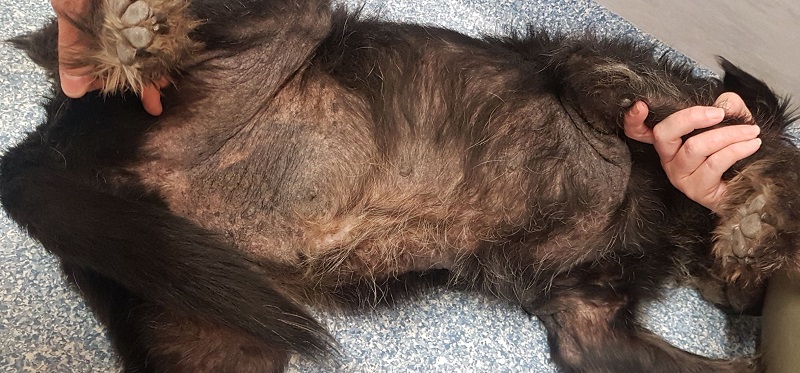
Formulating a diagnosis:
Following the history collection, and simple tests, we can rule in or rule out some of the simplest causes of itch: infestation by crawling parasites (fleas and Sarcoptic Mange), the presence of bacterial and fungal infections.
Dog allergy causes:
We then devise a short list of causes of Allergic Skin Disease in your pet. These may include:
- Flea allergy dermatitis (FAD) – the allergy to the bites of fleas
- Food allergy / Adverse Food reaction
- Atopic dermatitis of the dog and cat – Agents in the environment that result in skin allergy symptoms in your dog and cat
In some cases, there may be more than one of these causes. For further information on how we can distinguish the above causes together, please see Dog Skin Allergy and Cat Skin Allergy diagnosis.
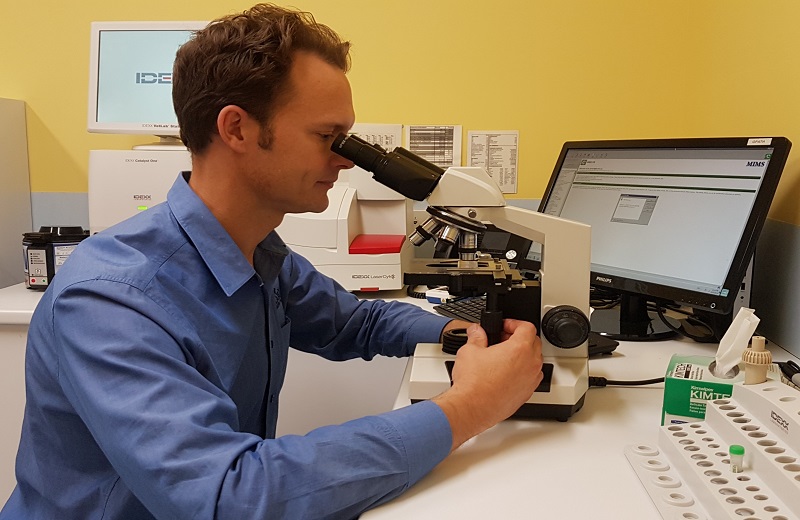
Dog Skin Allergy and Cat Skin Allergy diagnosis
Diagnostic trials for Skin Allergy in the dog and cat:
We then start with a combined, quite rapid approach to narrowing down the likely allergy from this group. This may begin with a Flea Elimination Trial and Elimination Diet Trial. These trials on their own are useful diagnostic tools.
Unfortunately, we do need to rule out fleas and food as possible causes before we can arrive at a reliable diagnosis of atopy in most patients. But we have very good systems to streamline the diagnostic approach. A diagnosis of flea allergy or food allergy is simple to make, and very simple to manage, so a little work on ruling these in is very worthwhile.
As far as Atopic Dermatitis goes, we cannot run a test that will tell us your pet has this condition – it is a diagnosis of exclusion, which means we can only arrive at this diagnosis by ruling out all the other causes above. Once we diagnose atopy however, we have very reliable techniques to work out exactly what the cause of the allergies are.
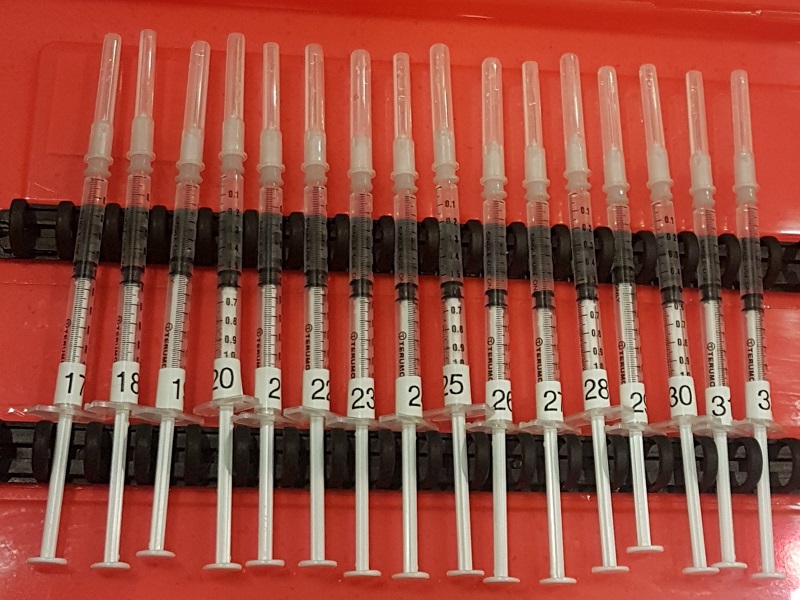
Atopic Dermatitis is defined broadly as an allergic reaction to agents in the environment that results in the over-activation of the patient’s immune system to those agents.
The agents in the environment can be broadly divided into the following categories:
- Grasses
- Trees
- Weeds
- Plants
- Insects
- Moulds
We use Intradermal Skin Allergy Testing (ISAT) and also Serum Allergy Testing to help us identify the exact causes of your pet’s allergies (the allergens). ISAT involves your pet staying in the clinic for the day and undergoing light sedation. We then test your pet’s reactivity to around 60 different allergy-causing agents (allergens) in total by injecting very small amounts of these agents into the skin. The allergens used in ISAT are chosen carefully to ensure they are found in your local environment.
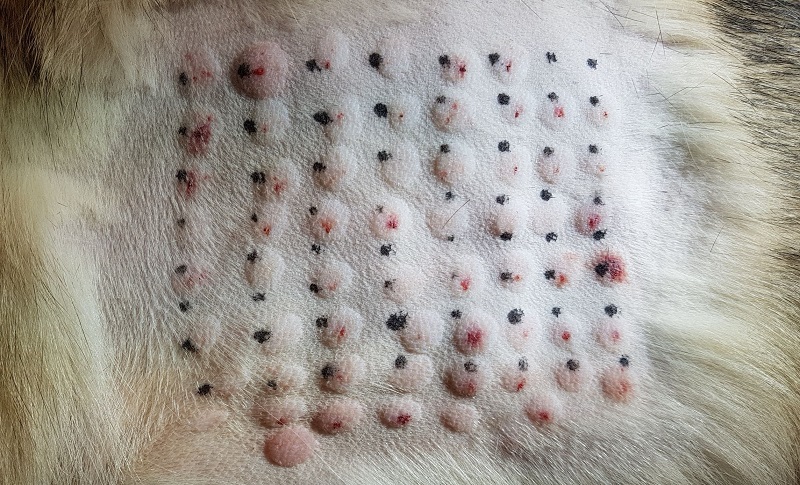
Similar to human pinprick type allergy testing, after several minutes, ISAT results in development of a wheal response to the offending allergens. The responses to the individual allergens can be easily measured and graded to then provide us with a shortlist of exact agents. For example, your dog may have three particular grass species as strong reactors (Ryegrass, Phalaris and Brome Grass) and also show strong responses to House Dust Mite species, and maybe several particular types of moulds. For many dogs and cats, there are 10-20 specific allergens identified as strong reactors.
Subcutaneous Immunotherapy, also called Allergen Specific Immunotherapy (ASIT)
Following Intradermal Skin Allergy Testing and sometimes also Serum Allergy Testing we will have positively identified the exact causes of your pet’s allergies (the allergens). Then we can create vaccine that we can use in a process called Allergy Desensitization / Allergen Specific Immunotherapy (ASIT). The process of creating the “skin allergy vaccine” can be quite involved, and requires careful selection of the right allergens to make a “recipe” that will work effectively.
ASIT works by exposing your pet’s immune system to minute causes of the allergens, and gradually increasing the amount of allergen they are exposed to. During this process, the body’s immune system learns to tolerate the offending allergens, so that the allergic response during “real life’ allergy exposure is far less intense. By starting with very low doses of the allergens in the vaccine, we have a very safe exposure regime. In time, we gradually increase the dose of allergen they are exposed to, up till a point where we reach a constant dose. This is usually around 12 weeks into the Vaccination Schedule.
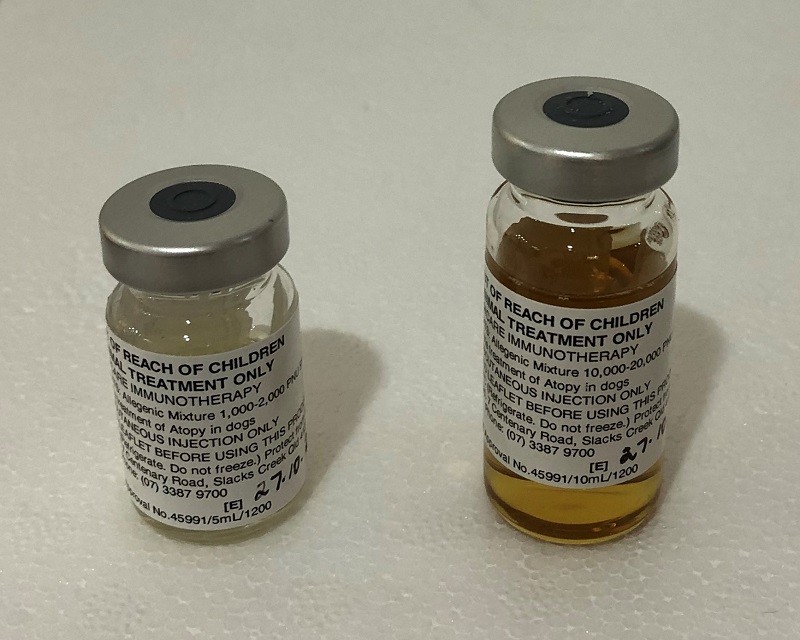
ASIT vaccine can be easily administered by our staff for you, or if you feel comfortable to administer it yourself, we are happy to train you on this very simple technique.
ISAT can produce a significant reduction in allergy symptoms in most patients suffering from Atopic Dermatitis. In fact, more than 2/3 of patients will benefit, and more than 1/3 will be completely cured of their allergic symptoms. ASIT is certainly the safest and most effective way to manage atopic dermatitis.
Please contact Vet Skin and Ear for further information.



